
The Russulales are an order of the Agaricomycetes,. According to the Dictionary of the Fungi, the order consists of 12 families, 80 genera, and 1767 species. According to Species Fungorum, the order contains 13 families, 117 genera, and 3,060 species.

The Russulaceae are a diverse family of fungi in the order Russulales, with roughly 1,900 known species and a worldwide distribution. They comprise the brittlegills and the milk-caps, well-known mushroom-forming fungi that include some edible species. These gilled mushrooms are characterised by the brittle flesh of their fruitbodies.
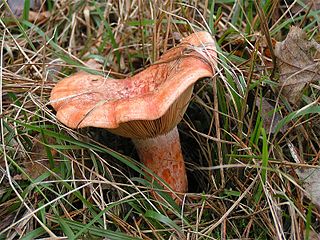
Lactarius deliciosus, commonly known as the saffron milk cap and red pine mushroom, is one of the best known members of the large milk-cap genus Lactarius in the order Russulales. It is found in Europe and has been accidentally introduced to other countries under conifers and can be found growing in pine plantations. A fresco in the Roman town of Herculaneum appears to depict Lactarius deliciosus and is one of the earliest pieces of art to illustrate a fungus.

Auriscalpium is a genus of mushrooms typifying the family Auriscalpiaceae.

Pleurotus is a genus of gilled mushrooms which includes one of the most widely eaten mushrooms, P. ostreatus. Species of Pleurotus may be called oyster, abalone, or tree mushrooms, and are some of the most commonly cultivated edible mushrooms in the world. Pleurotus fungi have also been used in mycoremediation of pollutants, such as petroleum and polycyclic aromatic hydrocarbons.

The Auriscalpiaceae are a family of fungi in the order Russulales. Like much of the Russulales, it has been defined through molecular phylogeny, and includes physically dissimilar species, such as the tooth fungus Auriscalpium and the gilled, often shelf-like members of Lentinellus.

The Bondarzewiaceae are a family of fungi in the order Russulales. The type species for both its genus and the family as a whole, Bondarzewia montana, closely resembles members of Polyporales, but has ornamented spores like those of Lactarius or Russula. This characteristic suggested the relationship between physically dissimilar species that eventually led to the restructuring of Russulales using molecular phylogeny. According to the Dictionary of the Fungi, the family contains 8 genera and 48 species.

Neolentinus lepideus is a basidiomycete mushroom of the genus Neolentinus, until recently also widely known as Lentinus lepideus. Common names for it include scaly sawgill, scaly lentinus and train wrecker.
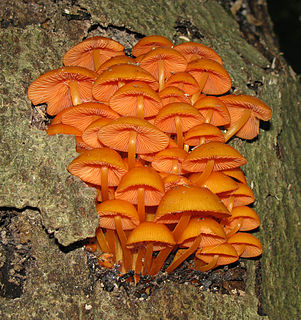
Mycena leaiana, commonly known as the orange mycena or Lea's mycena, is a species of saprobic fungi in the genus Mycena, family Mycenaceae. Characterized by their bright orange caps and stalks and reddish-orange gill edges, they usually grow in dense clusters on deciduous logs. The pigment responsible for the orange color in this species has antibiotic properties. A variety of the species, Mycena leaiana var. australis, can be found in Australia and New Zealand.

Lentinellus cochleatus, commonly known as the aniseed cockleshell, is a wood-inhabiting fungus. It has a mild aniseed odor and flavor. Like all species in its genus, it is inedible due to its bitterness.
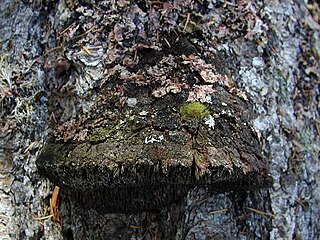
The Echinodontiaceae are a family of crust fungi in the order Russulales. Species of this family, divided amongst two genera—Echinodontium and Laurilia—have a widespread distribution, although they are especially predominant in north temperate zones. They are parasitic or saprobic on wood, and may cause white rot of angiosperms and gymnosperms.

Panus conchatus, commonly known as the lilac oysterling, is an inedible species of mushroom that occurs throughout the Northern Hemisphere. Its fruitbodies are characterized by a smooth, lilac- or tan-colored cap, and decurrent gills. The fungus is saprophytic and fruits on the decomposing wood of a wide variety of deciduous and coniferous trees. Despite being a gilled species, phylogenetic analysis has shown it is closely related to the pored species found in the family Polyporaceae.
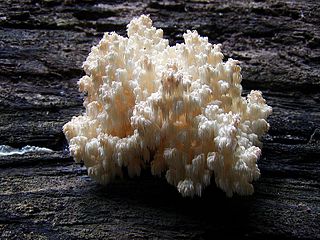
Hericium is a genus of edible mushrooms in the family Hericiaceae. Species in this genus are white and fleshy and grow on dead or dying wood; fruiting bodies resemble a mass of fragile icicle-like spines that are suspended from either a branched supporting framework or from a tough, unbranched cushion of tissue. This distinctive structure has earned Hericium species a variety of common names—monkey's head, lion's mane, and bear's head are examples. Taxonomically, this genus was previously placed within the order Aphyllophorales, but recent molecular studies now place it in the Russulales.
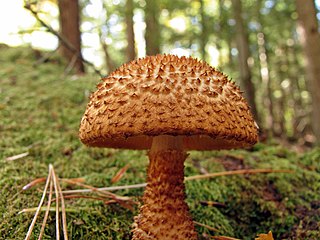
Leucopholiota decorosa is a species of fungus in the mushroom family Tricholomataceae. Commonly known as the decorated pholiota, it is distinguished by its fruit body which is covered with pointed brown, curved scales on the cap and stem, and by its white gills. Found in the eastern United States, France, and Pakistan, it is saprobic, growing on the decaying wood of hardwood trees. L. decorosa was first described by American mycologist Charles Horton Peck as Agaricus decorosus in 1873, and the species has been transferred to several genera in its history, including Tricholoma, Tricholomopsis, Armillaria, and Floccularia. Three American mycologists considered the species unique enough to warrant its own genus, and transferred it into the new genus Leucopholiota in a 1996 publication. Lookalike species with similar colors and scaly fruit bodies include Pholiota squarrosoides, Phaeomarasmius erinaceellus, and Leucopholiota lignicola. L. decorosa is considered an edible mushroom.
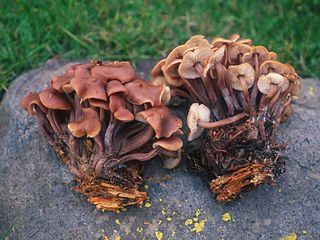
Connopus is a fungal genus in the family Marasmiaceae. The monotypic genus was circumscribed in 2010 to accommodate the species Connopus acervatus, formerly in the genus Gymnopus. It is found in North American and Europe, where it grows in dense clusters on decaying wood. It is regarded as inedible.
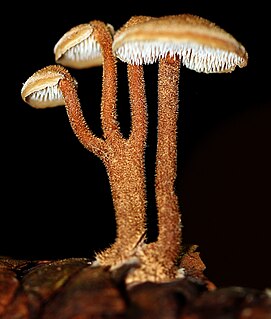
Auriscalpium vulgare, commonly known as the pinecone mushroom, the cone tooth, or the ear-pick fungus, is a species of fungus in the family Auriscalpiaceae of the order Russulales. It was first described in 1753 by Carl Linnaeus, who included it as a member of the tooth fungi genus Hydnum, but British mycologist Samuel Frederick Gray recognized its uniqueness and in 1821 transferred it to the genus Auriscalpium that he created to contain it. The fungus is widely distributed in Europe, Central America, North America, and temperate Asia. Although common, its small size and nondescript colors lead it to be easily overlooked in the pine woods where it grows. A. vulgare is not generally considered edible because of its tough texture, but some historical literature says it used to be consumed in France and Italy.

Lentinellus montanus is a species of agaric fungus in the family Auriscalpiaceae. It is found at high elevations in the Pacific Northwest region of North America, where it fruits singly or in clumps on decaying conifer wood.
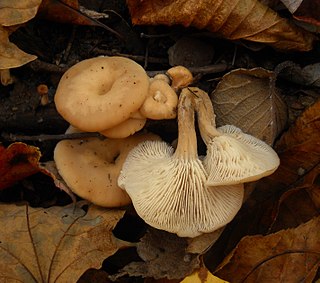
Lentinellus micheneri is a species of wood-inhabiting fungus in the family Auriscalpiaceae. It was first described in 1853 by mycologist Miles Berkeley and Moses Ashley Curtis as Lentinus micheneri. David Pegler transferred it to the genus Lentinellus in 1983. Like all species in its genus, it is inedible.

Mycetinis scorodonius is one of the garlic-scented mushrooms formerly in the genus Marasmius, having a beige cap of up to 3 cm and a tough slender stipe.

Lentinellus ursinus is a species of fungus belonging to the family Auriscalpiaceae. Like all species in its genus, it is inedible due to its bitterness.



















